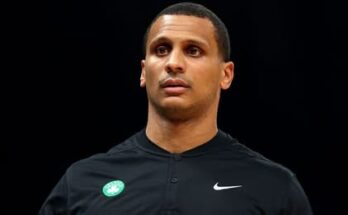Edmonton Oilers’ Media Fantasies Revolve Around Acquiring Islanders’ Cornerstone Star as NHL Trade Rumors Escalate and Fan Pressure Mounts Ahead of Critical Season
In a city where hockey isn’t just a sport but a public obsession, the Edmonton Oilers have become the epicenter of a fervent media campaign driven not by official team moves, but by dreams—specifically, dreams of pulling off a blockbuster trade involving one of the New York Islanders’ most valued assets. As the offseason unfolds and the Oilers attempt to regroup from another painful Stanley Cup Final loss, a growing chorus of Edmonton media figures, insiders, and fans alike have zeroed in on two names: Jean-Gabriel Pageau and Ilya Sorokin. These names have become shorthand for something deeper—an Oilers fanbase hungry for change, desperate for security in net, and determined to seize on any opportunity to improve in the narrow window left before their core stars age out of their prime. And while no deal has come to fruition, the speculation has taken on a life of its own, evolving from whisper to wildfire.
Jean-Gabriel Pageau, a gritty, two-way center with playoff pedigree and the kind of faceoff and penalty-kill reliability coaches covet, has long been admired in Western Canada. He first drew serious attention from the Oilers’ front office during last season’s trade deadline period. The Islanders were believed to be open to conversations, but negotiations reportedly fizzled due to cap concerns and New York’s refusal to retain salary. Still, that brief moment of tension between possibility and inaction has since become a favorite topic of Edmonton-based analysts and writers, who regularly revisit it in columns and podcasts as a missed opportunity the team could still revisit. With only one year remaining on his $5 million AAV contract, Pageau is seen as a low-risk acquisition with a high-impact playoff upside. His ability to win key draws, provide shutdown matchups, and support secondary scoring is exactly the kind of depth the Oilers lacked in key postseason moments.
But if Pageau represents a practical dream, then Ilya Sorokin embodies a far more audacious one. Considered one of the NHL’s most technically sound goaltenders, Sorokin is entering his prime and signed through 2031 on a $66 million contract. Though not coming off a career year by his own high standards, he remains elite—capable of game-stealing performances and stabilizing chaos in front of the net. For Oilers media, Sorokin represents the Holy Grail: a long-term solution to the team’s most persistent and painful flaw. The inability to find consistent, elite goaltending has haunted Edmonton through multiple playoff exits and crushed otherwise dominant runs. It is not lost on fans or media that Sorokin’s presence between the pipes could have changed the outcome of their latest Final appearance, where they were ultimately outdueled at the most critical position on the ice.
This fantasy has ignited a flood of proposed trade scenarios, salary cap gymnastics, and roster restructuring exercises across Edmonton’s sports discourse. Commentators openly imagine what a package would look like—some proposing a deal centered around Stuart Skinner and a first-round pick, others envisioning a more drastic cap-clearing move involving multiple contracts. Skinner, who has admirably carried much of the goaltending load during the team’s recent postseason runs, has nonetheless shown vulnerability under pressure. And while Calvin Pickard has earned respect as a serviceable backup, neither he nor Skinner are viewed as championship-level solutions on their own. The idea of replacing one with Sorokin isn’t just about skill—it’s symbolic of decisiveness, of being all-in during what may be the final years of the McDavid-Draisaitl era.
There’s a realism gap between media fantasy and team strategy, however, and both insiders and the front office know it. The Islanders have given no real indication that they’re shopping Sorokin, who is under contract and viewed as the backbone of their current roster. Jean-Gabriel Pageau, on the other hand, may be more attainable, but not without significant negotiation—and likely without the Oilers being willing to overpay for what New York still considers a valuable playoff asset. Sources around the league suggest that while Oilers general manager Stan Bowman has considered upgrades down the middle and in net, the obstacles to such blockbuster deals remain immense. The cap space is tight, the asset pool is no longer as deep as it once was, and every move must be weighed against how it affects Edmonton’s long-term sustainability, not just their short-term desperation.
Yet these cold logistical realities have not dulled the passion from the Edmonton media machine. Instead, they have fueled it. The more improbable the trade, the more enticing it becomes. The Oilers’ fanbase, one of the most vocal and invested in the NHL, has shown no signs of wanting to slow down this speculation. Instead, they participate in it enthusiastically—creating mock trades, debating lineup chemistry with Sorokin or Pageau in the mix, and challenging team leadership to stop playing conservatively and swing big. The emotional residue of back-to-back near-misses in the Stanley Cup Final has created a climate where patience is thin and ambition is expected. No longer satisfied with simply competing, Oilers fans now demand dominance.
That pressure has extended to the players, too. Connor McDavid, widely regarded as the best player in the world, has remained publicly supportive of management but is undoubtedly aware of the ticking clock on his prime. Leon Draisaitl’s future in Edmonton remains uncertain, and every unmade move increases the tension surrounding his next contract. The idea of wasting another year with subpar goaltending or shallow depth at center is increasingly unacceptable to a fanbase that believes it is owed more. For many, the failure to even seriously attempt acquiring someone like Sorokin or Pageau would signal complacency—and risk squandering what little championship window remains.
It is in this highly pressurized environment that the media fantasy continues to thrive. Some observers have criticized the persistent speculation, warning that unrealistic expectations can destabilize a team’s culture and lead to public disappointment when fantasy fails to meet reality. Others see it differently, arguing that in a market like Edmonton, dreaming big is not just a pastime but a necessary part of fandom. Media speculation, in this view, serves as a catalyst—pressuring management, stoking public engagement, and keeping players accountable to more than just the scoreboard. It keeps the team in the national conversation and makes clear that merely good is no longer good enough.
From the Islanders’ perspective, they remain publicly committed to both Pageau and Sorokin. New general manager Mathieu Darche has given no public indication that either player is being shopped, and insiders close to the organization suggest they’re more likely to retool around those players than move them. Still, nothing is impossible in the NHL, especially as the cap rises and trade demands become more creative. If the Islanders falter early or decide to rebuild more aggressively, their stance may shift. Should that moment arrive, it’s all but certain that Edmonton will be one of the first teams back on the phone—ready to revisit a dream they’ve been publicly entertaining for months.
Until then, the speculation will continue. The Oilers’ media ecosystem will go on spinning scenarios, weighing player comparisons, and urging the franchise to aim higher. Whether it’s a practical move for Pageau or a full-throttle play for Sorokin, the fantasy remains irresistible. It is the product of unmet expectations, unfinished business, and a deep, aching desire to finally end the longest Stanley Cup drought in Canadian history. For now, the trades live only in headlines and hashtags, but the belief that something big must happen soon is growing louder by the day. And in a city where hockey never sleeps, the dream of bringing an Islanders cornerstone to Edmonton isn’t just speculation—it’s the story that won’t go away.



